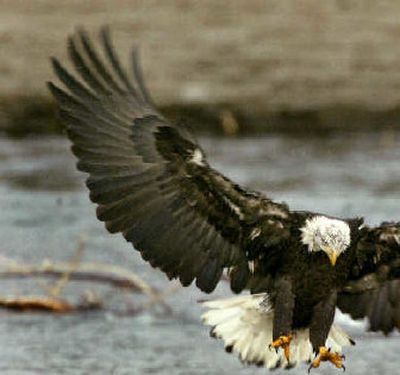Skagit eagle count sets record

ROCKPORT, Wash. – Recent record rain, snow and ice storms in Washington state that downed power lines and caused millions of dollars in property damage had at least one salutary effect: A record number of bald eagles were counted in Skagit County, north of Seattle.
Jim Alt, a bald eagle expert for the Nature Conservancy, stands on the bank of the Skagit River in Howard Miller Steelhead Park. From a clearing of hemlock, cottonwood, alder and silver fir trees, he points to a rocky bar in the river.
“On Jan. 2, there were 350 birds right here,” he says. “I couldn’t believe it. I thought I made a mistake. It was an incredible sight.”
The annual National Midwinter Bald Eagle Survey coordinated by the U.S. Geological Survey occurs in 42 states and has helped document the recovery of the bald eagles, whose numbers had dropped by 1963 to only 417 nesting pairs in the lower 48 states.
The birds were listed as an endangered species in 1967, even before the Endangered Species Act became law in 1973.
Yet by 1995, the population had recovered to the point where its official status was changed from endangered to threatened. Today, there are more than 7,000 nesting pairs living in the contiguous U.S., and this month the U.S. Fish and Wildlife Service is expected to announce the complete de-listing of the birds.
In most places the counting occurs over one week in January. But in the Skagit River Bald Eagle Natural Area, 8,000 acres overseen by the Nature Conservancy, the birds are counted weekly from November through February, when the eagles return north to their nesting areas.
Most of these eagles nest and breed in Alaska and western Canada. “The more ice and snow in the winter, the farther south the birds will fly to find food,” says Jim Watson, a wildlife researcher with the Washington State Department of Fish and Game who studies migratory birds. “And most of our harsh weather this year came from the north. That may have brought more eagles to the Skagit River this year.”
Counting eagles isn’t an exact science. Alt carries a notebook and records the birds he sees in half-mile segments of his 12-mile territory along the river. While it is possible that some birds are counted twice – or overlooked because the counting is done on a weekly basis during the winter roosting period – comparing the numbers week to week, year to year, validates the process.
And Alt clearly knows what he’s doing. He records the behavior of each bird he counts – eating, perching, circling – and its age – adult, sub-adult, juvenile.
Young eagles are easy to spot, he says. “It isn’t just the heads, it’s also their size, and they way they fly.”
The juveniles have brown heads, which turn to white as they mature over four to five years. The growing birds are larger than adult birds, with extra feathers to help them fly.
“Given the record number of breeding pairs distributed across the country, the evidence suggests that the bald eagle no longer needs the protection of the Endangered Species Act,” says Chris Tollefson, chief of public affairs for the Fish & Wildlife Service.
The species still will have protection under other regulations, including the Bald and Golden Eagle Protection Act and the Migratory Bird Treaty Act.
Most biologists attribute the eagle’s recovery in large part to the banning of the pesticide DDT in 1972. DDT was used widely to control insects, particularly mosquitoes. It not only directly poisoned the eagles and other birds; it thinned the shells of their eggs and drastically reduced the number of hatchlings that survived.
“We don’t really know why we had so many birds this year,” says Bob Carey, the Nature Conservancy’s program director for the Skagit River Bald Eagle Natural Area. “A lot of factors play into it – certainly the weather, but also the abundant food supply.”
The Skagit River is a spawning ground for five different species of salmon – including chum, which the eagles prefer.
“It’s one of the Nature Conservancy’s platform projects,” says Carey. “And it shows how powerful these kinds of conservation partnerships can be, and what a difference can be made in the course of 30 years. I don’t expect to see 580 eagles on the Skagit every winter, but our numbers are steadily increasing, and that’s incredibly gratifying.”